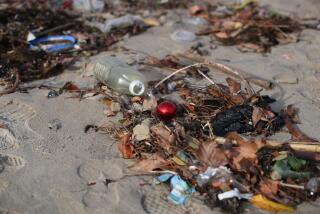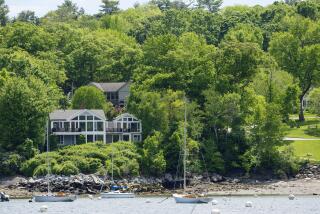Gulf of Maine Called a Victim of Littering : Environment: Students stage a massive cleanup of Maine’s coast, learning firsthand how plastics, beer cans and even $100 bills pose a deadly threat.
- Share via
GLEN COVE, Maine — Theo Keller found part of an answering machine. Bill Kinnane, his 11-year-old classmate, picked up milk cartons, napkins “and lots of beer cans.” Celina Morgan-Standard found so many disposable diapers that she wants people to start using cloth ones again.
Several years ago when these students from Riley School here joined hundreds of others around Maine for a coastal cleanup day, they had no trouble filling 20 bags with trash from a nearby beach. And they came away with some clear convictions about ocean dumping.
“I never really litter,” said Amy Halvorson. “But if I did I wouldn’t do it any more.”
“I don’t see how they can do that!” said Bill, talking about garbage barges that routinely dump city waste in the ocean. “They know what’s going to happen to all the animals.”
In September, these students took on the next round: the annual Gulf of Maine Coastal Cleanup, which turned out about 7,000 volunteers in Maine, New Hampshire and Massachusetts--and, for the first time, the Canadian provinces of New Brunswick and Nova Scotia. In Maine, the cleanup was part of Coastweek ‘89, a three-week celebration observed by more than 30 states that focuses on the value of the nation’s coasts.
The cleanup has had “great impact,” said Kathryn Jennings, head teacher at Riley School. Her students, she noted, are “very much aware of what litter can do, and they’re very aware of what they can do.”
And that, says Flis Schauffler, is exactly what the cleanup is intended to do. “There are so many environmental issues today that are of a scale that people just can’t get a grasp on, like tropical deforestation or global warming,” said Schauffler, who is communications coordinator for the Maine Coastal Program in the State Planning Office in Augusta. “There isn’t that much that kids in a classroom can do. This offers them something where they can learn about the resource and really make a difference in terms of hands-on stewardship.”
Richard H. Silkman, director of the Planning Office, agrees. “I don’t think it’s necessarily to clean up the shore,” he said. “I think it’s to draw attention to the fact that ocean dumping--trash--ends up someplace and can cause substantial damage. It’s really to focus people’s attention on the fact that this is a major issue for us.”
For that reason, he says, the bags of litter aren’t as important as the 8 1/2- by 14-inch cards labeled “Items Collected” that each beach-combing team tallies up. The cards list 65 different types of debris, from beverage bottles and egg cartons to 55-gallon drums and lobster traps. Volunteers record each item--and use slots labeled “Other” for the refrigerators, engine blocks, bedsprings, kitchen sinks, diamond necklaces and $100 bills that have been found in past cleanups.
Starting with the 1988 cleanup, the information from the cards goes into the National Marine Debris Database, maintained by the Washington-based Center for Marine Conservation. The center’s 1988 report--based on cards submitted by more than 47,500 volunteers in 25 states and territories who picked up nearly 2 million items on 3,500 miles of U. S. shoreline along the oceans and the Great Lakes--found that:
* The Gulf of Mexico, heavily used for shipping and offshore oil production, was the worst victim. Volunteers in Texas, for example, found 3,549 pounds of debris per mile.
* By contrast, the Gulf of Maine remains one of the cleanest coastal regions. Massachusetts registered 333 pounds per mile, while Maine had only 133 pounds.
* Nationally, the most prevalent type of debris was plastic--which is not surprising since it often floats. About 62% of the items found were plastic, followed by paper (11.8%), metal (11.4%), glass (9.5%), wood (2.3%) and cloth (1.3%).
* Not all the trash is generated by Americans. More than 1,000 “foreign-label items” from 46 countries were also counted. “Much of the foreign debris found on U. S. beaches can be attributed to dumping by the international fleet of commercial ships,” says the CMC report, adding that some debris also comes from cruise liners.
* Some of the most compelling reasons to stop ocean littering come from the animal kingdom, as volunteers reported evidence of birds and mammals caught in nets or in plastic six-pack yokes. According to National Wildlife Federation estimates, 1 million sea birds and 100,000 marine mammals die each year from ingesting or becoming entangled in marine debris.
The limiting factor, says Sartwell, is access to the beaches. Much of the coastline is privately owned. Even in public areas, however, groups of children need to have access to bathroom facilities, telephones (in case of emergency) and trucks to haul off the bags of trash they collect.
“That pretty much limits us to the state parks and to the town-owned beaches,” she said, noting that she has not received offers from private owners to open their coastlines for the day.
The information gathered about the source of the litter will help determine what steps to take. There already have been efforts to improve trash-disposal facilities at marinas, Silkman said. The Maine Coastal Program published a booklet, “Charting Our Course,” which is an activity guide for grades six through 12 on water quality in the Gulf of Maine. And a working conference on the Gulf of Maine, convened by the governors of Massachusetts, New Hampshire and Maine and the premiers of New Brunswick and Nova Scotia, is scheduled Dec. 10, 11 and 12 in Portland.
“In the same way we went through the 1960s with an anti-litter campaign for the highways--basically we’ve got to go through that same exercise on the ocean,” Silkman said. “There is this sense that things sink and go to the bottom,” when in fact much of the debris comes ashore.
“This is a preventive program,” said David Keeley, director of the Maine Coastal Program, who hopes to stimulate political action to protect the Gulf of Maine while it is still healthy. “How do you get people to respond when there’s not a crisis? Getting people to think about it is one of the first steps.”
To the untrained eye, the Gulf of Maine is just a chunk of open ocean embraced by Cape Cod to the south and Nova Scotia to the north. In fact, it’s often called “a sea within a sea” because of its unusual bathymetric characteristics.
To the south, its sea floor is bounded by Nantucket Shoals and Georges Bank--where the water is sometimes only 13 feet deep. Browns Bank wraps around from the northeast. To the east lies a narrow stretch of deep water known as Northeast Channel--the only escape for the water pouring in from the region’s many rivers.
Contained by these boundaries, water within the gulf circulates counterclockwise in what scientists call a gyre. The influx of fresh water brings up nutrients from the bottom, causing an abundance of plant and animal life. As a result, the gulf differs significantly from the open ocean in temperature, salinity and biota.
“The Gulf of Maine is not the Atlantic Ocean,” said David Keeley, director of the Maine Coastal Program. “It’s not like New Jersey, where you look out to Spain. The Gulf of Maine is really an ecosystem.”
And so far, it’s a healthy one--unlike the Gulf of Mexico, which in some ways it resembles.
Keeping the Gulf of Maine pristine, he says, is especially important. That means controlling not only visible trash but less visible chemicals and storm-sewer runoff. Because of the gyre effect, pollutants get trapped in the region. “What somebody puts in in Massachusetts circulates--it doesn’t wash away,” he said, noting that trash dumped off Cape Cod can find its way to Nova Scotia--and back again.
More to Read
Sign up for Essential California
The most important California stories and recommendations in your inbox every morning.
You may occasionally receive promotional content from the Los Angeles Times.










